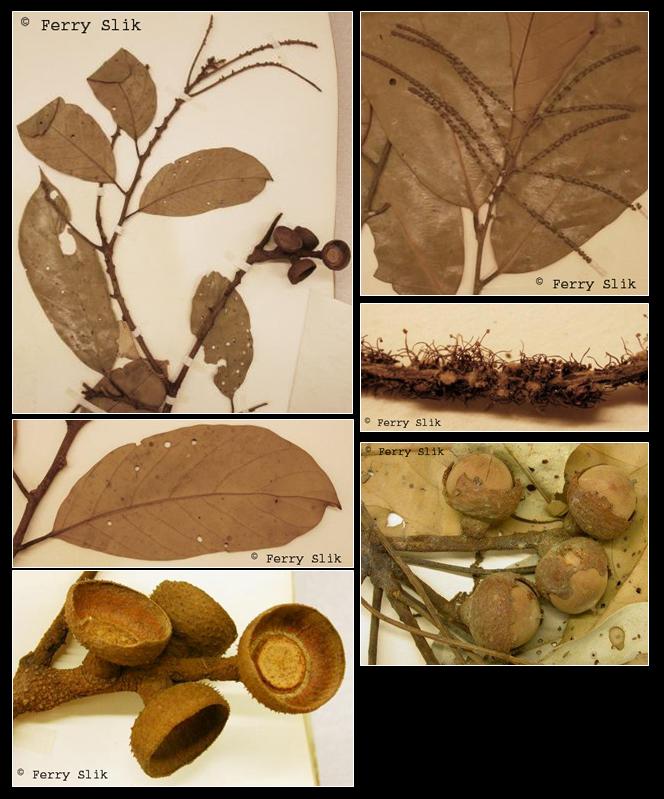Lithocarpus urceolaris (Jack) Merr., J. Arn. Arb. 33 (1952)
Latin for 'jar- or urn-shaped', referring to the acorn.Synonyms
Lithocarpus cratephora (Fischer) A.Camus
Pasania craterophora Fischer
Pasania oligoneura (Korth.) Oerst
Pasania urceolaris (Jack) Oerst
Quercus oligoneura Korth.
Quercus urceolaris Jack
Diagnostics
Mid-canopy tree up to 34 m tall and 64 cm dbh. Leaves alternate, simple,
penni-veined, glabrous to hairy below. Flowers ca. 3 mm diameter, yellow, placed
in racemes. Fruits ca. 24 mm diameter, green-grey-brown, nut halve enclosed by
cupule.
Description
Tree up to 35 m tall, 70 cm diameter. Bark fissured, lenticellate, pale reddish brown;
inner bark fibrous, brownish. Sapwood brownish. Twigs sparsely to densely tomentose,
sparsely or densely lenticellate. Stipules narrowly ovate to linear, 2-3 x 1 mm. Leaves
coriaceous, sparsely to densely tomentose or sometimes glabrous above, densely tomentose
with appressed stellate or sometimes mixed with stiff hairs below; elliptic, obovate, oblong
or lanceolate, 12-16.5(-35) x 5-9(-10) cm, base acute to cuneate, rarely rounded, margin
revolute, apex sharply acute to acuminate, acumen 10-25 mm long; midrib broad, flat
or slightly raised above, strongly raised below; lateral veins thin, (6-)7-12 pairs, lax,
flat or impressed or sometimes obscure above, raised below, disappearing near the leaf
margin, forming an angle of 40-60 degrees with the midrib; intercostal venation scalariform,
dense, obscure above, thin and prominent below; petiole 5-8 mm long. Inflorescences
male or androgynous. Male inflorescences 15-20(-25) cm long; bracts elliptic, c. 1 x
0.3 mm; bracteoles linear, c. 0.5 x 0.2 mm. Male flowers solitary along the rachis; perianth
lobes obtuse, c. 1 x 0.9 mm; stamen filaments 2-3 mm long; pistillode globose, c. 0.5
mm diameter. Androgynous inflorescences 12-25 cm long; bracts ovate, c. 0.8 x 0.5
mm. Female flowers solitary along the rachis; perianth lobes acute, c. 1 x 0.6 mm;
staminodes 10; styles conical, recurved, 1-1.5 mm long. Cupules solitary or rarely in
clusters of 3 along the rachis, with stalk 5-8 mm long, cup-shaped, (0.5-)1.5-3.5 x 2.5-
3.5 cm, densely tomentose, minutely scaly or lamellate; wall woody, thick, densely hairy,
enclosing up to half of the acorn; lamellae obscure, or if scaly, the scale-like appendages
distinct, set in irregular lines. Acorns depressed globose, 2-4 x 2-3.5 cm, most part
exserted, densely tomentose, brownish; base flat, apex acute or rounded; scar concave,
1-1.5 cm diameter; wall woody, thick, most part free from the cupule. [from Tree Flora of
Sabah and Sarawak]
Ecology
In undisturbed to slightly disturbed mixed dipterocarp and sub-montane
forests up to 1700 m altitude. Mostly on hillsides and ridges, but also along
rivers. Mostly on sandy soils, but also found on limestone.
Distribution
Peninsular Malaysia, Sumatra, Borneo.
Local names
Borneo: Berangan, Brangan gasing, Mempening, Palele, Paning-paning, Pipit.
